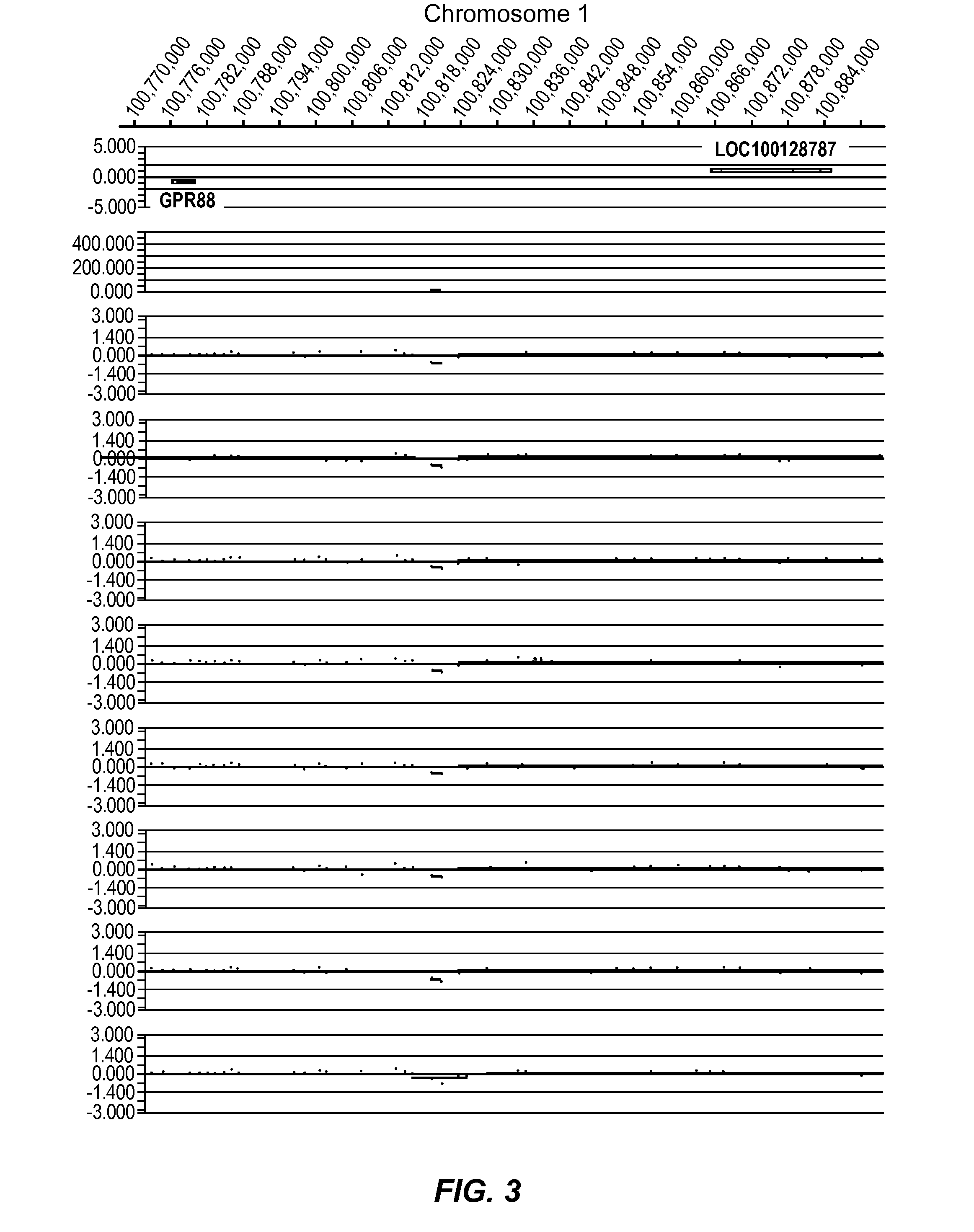Methods and Compositions for Diagnosing, Prognosing, and Treating Neurological Conditions
a neurological condition and composition technology, applied in the field of neurological condition diagnosis, prognosis and treatment, can solve the problems of rare variants of the majority of the population, and achieve the effects of reducing ci activity, shortening the length, and reducing ci activity
- Summary
- Abstract
- Description
- Claims
- Application Information
AI Technical Summary
Benefits of technology
Problems solved by technology
Method used
Image
Examples
example 1
[0413]In the present study, data was generated on the basis of a comparison of copy number variants (CNVs) identified in 2 cohorts:
1. 1,005 Normal individuals (Normal Variation Engine—NVE);
2. 468 Parkinson's Disease (PD) cases (samples obtained from the The Parkinson's Institute and Clinical Center (PI), Sunnyvale, Calif. 94085, USA).
[0414]Genomic DNA samples from individuals within the Normal cohort (NVE ‘test’ subjects) and from the PD cohort (PD ‘test’ subjects) were hybridized against a single, sex-matched reference individual as follows. Reference DNA samples were labeled with Cy5 and test subject DNA samples were labeled with Cy3. After labeling, samples were combined and co-hybridized to Agilent 1M feature oligonucleotide microarrays, design ID 021529 (Agilent Product Number G4447A) using standard conditions (array Comparative Genomic Hybridization—aCGH). Post-hybridization, arrays were scanned at 2 μm resolution, using Agilent's DNA microarray scanner, generating tiff images...
example 2
[0426]Some pathway analysis software will be used to identify whether the candidate gene will be a drug target, which may be FDA-approved or in clinical trials. Such information will assist in the design of clinical trials (e.g., patient stratification for genetic subtypes) or will be used to facilitate clinical trials that are in progress, thereby reducing the attrition rate (failure to receive FDA approval) and reducing the time and cost of drug development. If a candidate PD gene is identified as a known drug target of an FDA-approved therapeutic, the drug can be repurposed and approved for use in a new indication (e.g., a cancer or anti-inflammatory agent may be beneficial to PD patients as well). Those skilled in the art will recognize that Phase II and III failures may be rescued with additional clinical trial data that accounts for genetic subtypes, particularly when the drug fails for lack of efficacy. For example, if a drug is designed or established to target a particular ...
example 3
[0427]Sanger sequencing was performed on 478 cases in the PD cohort. Exons and flanking sequence of the PD candidate gene NUBPL were sequenced bi-directionally. Briefly, PCR amplification was carried out in an 5 μl amplification solution comprising AmpliTaq Gold®, PCR Master Mix (Applied Biosystems), a solution containing the target polynucleotide, and a forward PCR primer and reverse PCR primer (as indicated below).
[0428]The PCR samples were thermal cycled to conduct PCR in a thermal cycler. A two-step “boost / nest” PCR strategy was used. An initial boost reaction generating a larger fragment was performed, followed by a nest reaction, using the initial product as a template for the nest. The nest product was then sequenced. All products were sequenced on ABI 3730XL DNA sequencers.
[0429]Millipore Montage PCR384 plates were used for PCR cleanup (the boost reaction was not cleaned up, only the nest reaction). The primers utilized were as follows:
TABLE 6N-B-Sequence_IDNST5′NST3′LENBST5...
PUM
| Property | Measurement | Unit |
|---|---|---|
| Fraction | aaaaa | aaaaa |
| Fraction | aaaaa | aaaaa |
| Fraction | aaaaa | aaaaa |
Abstract
Description
Claims
Application Information
 Login to View More
Login to View More - R&D
- Intellectual Property
- Life Sciences
- Materials
- Tech Scout
- Unparalleled Data Quality
- Higher Quality Content
- 60% Fewer Hallucinations
Browse by: Latest US Patents, China's latest patents, Technical Efficacy Thesaurus, Application Domain, Technology Topic, Popular Technical Reports.
© 2025 PatSnap. All rights reserved.Legal|Privacy policy|Modern Slavery Act Transparency Statement|Sitemap|About US| Contact US: help@patsnap.com



